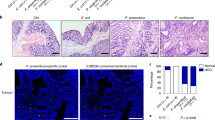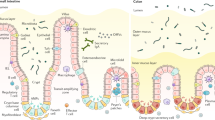Abstract
Development of colon cancer is a multistep process that is regulated by intrinsic and extrinsic cellular signals. Extrinsic factors include molecular patterns that are derived from either pathogens (PAMPs) or cellular damage (DAMPs). These molecules can promote tumourigenesis by activation of the innate immune system, but the individual contribution of ligands and their receptors remains elusive. The receptor for advanced glycation end products (Rage) is a pattern recognition receptor that binds multiple ligands derived from a damaged cell environment such as Hmgb1 and S100 protein. Here we show that Rage signalling has a critical role in sporadic development of intestinal adenomas, as ApcMin/+ Rage−/− mice are protected against tumourigenesis.
This is a preview of subscription content, access via your institution
Access options
Subscribe to this journal
Receive 50 print issues and online access
$259.00 per year
only $5.18 per issue
Buy this article
- Purchase on Springer Link
- Instant access to full article PDF
Prices may be subject to local taxes which are calculated during checkout




Similar content being viewed by others
References
Greten FR, Eckmann L, Greten TF, Park JM, Li ZW, Egan LJ et al. IKKbeta links inflammation and tumorigenesis in a mouse model of colitis-associated cancer. Cell 2004; 118: 285–296.
Rakoff-Nahoum S, Medzhitov R . Regulation of spontaneous intestinal tumorigenesis through the adaptor protein MyD88. Science 2007; 317: 124–127.
Ekbom A, Helmick C, Zack M, Adami HO . Ulcerative colitis and colorectal cancer. A population-based study. N Engl J Med 1990; 323: 1228–1233.
Ekbom A, Helmick C, Zack M, Adami HO . Increased risk of large-bowel cancer in Crohn′s disease with colonic involvement. Lancet 1990; 336: 357–359.
Neufert C, Becker C, Neurath MF . An inducible mouse model of colon carcinogenesis for the analysis of sporadic and inflammation-driven tumor progression. Nat Protoc 2007; 2: 1998–2004.
Fukata M, Shang L, Santaolalla R, Sotolongo J, Pastorini C, Espana C et al. Constitutive activation of epithelial TLR4 augments inflammatory responses to mucosal injury and drives colitis-associated tumorigenesis. Inflamm Bowel Dis 2011; 17: 1464–1473.
Turovskaya O, Foell D, Sinha P, Vogl T, Newlin R, Nayak J et al. RAGE, carboxylated glycans and S100A8/A9 play essential roles in colitis-associated carcinogenesis. Carcinogenesis 2008; 29: 2035–2043.
Medzhitov R . Toll-like receptors and innate immunity. Nat Rev Immunol 2001; 1: 135–145.
van Zoelen MA, Achouiti A, van der Poll T . The role of receptor for advanced glycation endproducts (RAGE) in infection. Crit Care 2011; 15: 208.
Lotze MT, Tracey KJ . High-mobility group box 1 protein (HMGB1): nuclear weapon in the immune arsenal. Nat Rev Immunol 2005; 5: 331–342.
He M, Kubo H, Morimoto K, Fujino N, Suzuki T, Takahasi T et al. Receptor for advanced glycation end products binds to phosphatidylserine and assists in the clearance of apoptotic cells. EMBO Rep 2011; 12: 358–364.
Du YS, Zhu H, Fu J, Yan SF, Roher A, Tourtellotte WW et al. Amyloid-beta peptide-receptor for advanced glycation endproduct interaction elicits neuronal expression of macrophage-colony stimulating factor: a proinflammatory pathway in Alzheimer disease. Proc Natl Acad Sci USA 1997; 94: 5296–5301.
Karin M, Greten FR . NF-kappaB: linking inflammation and immunity to cancer development and progression. Nat Rev Immunol 2005; 5: 749–759.
Moser AR, Pitot HC, Dove WF . A dominant mutation that predisposes to multiple intestinal neoplasia in the mouse. Science 1990; 247: 322–324.
Lee SH, Hu LL, Gonzalez-Navajas J, Seo GS, Shen C, Brick J et al. ERK activation drives intestinal tumorigenesis in Apc(min/+) mice. Nat Med 2010; 16: 665–670.
Volp K, Brezniceanu ML, Bosser S, Brabletz T, Kirchner T, Gottel D et al. Increased expression of high mobility group box 1 (HMGB1) is associated with an elevated level of the antiapoptotic c-IAP2 protein in human colon carcinomas. Gut 2006; 55: 234–242.
Kang HJ, Lee H, Choi HJ, Youn JH, Shin JS, Ahn YH et al. Non-histone nuclear factor HMGB1 is phosphorylated and secreted in colon cancers. Lab Invest 2009; 89: 948–959.
Salama I, Malone PS, Mihaimeed F, Jones JL . A review of the S100 proteins in cancer. Eur J Surg Oncol 2008; 34: 357–364.
Heijmans J, Muncan V, Jacobs RJ, de Jonge-Muller ES, Graven L, Biemond I et al. Intestinal tumorigenesis is not affected by progesterone signaling in rodent models. PLoS ONE 2011; 6: e22620.
Constien R, Forde A, Liliensiek B, Grone HJ, Nawroth P, Hammerling G et al. Characterization of a novel EGFP reporter mouse to monitor Cre recombination as demonstrated by a Tie2 Cre mouse line. Genesis 2001; 30: 36–44.
Barker N, van Es JH, Kuipers J, Kujala P, van den BM, Cozijnsen M et al. Identification of stem cells in small intestine and colon by marker gene Lgr5. Nature 2007; 449: 1003–1007.
Cole AM, Myant K, Reed KR, Ridgway RA, Athineos D, van den Brink GR et al. Cyclin D2-cyclin-dependent kinase 4/6 is required for efficient proliferation and tumorigenesis following Apc loss. Cancer Res 2010; 70: 8149–8158.
Sakaguchi M, Murata H, Yamamoto K, Ono T, Sakaguchi Y, Motoyama A et al. TIRAP, an adaptor protein for TLR2/4, transduces a signal from RAGE phosphorylated upon ligand binding. PLoS ONE 2011; 6: e23132.
Gebhardt C, Riehl A, Durchdewald M, Nemeth J, Furstenberger G, Muller-Decker K et al. RAGE signaling sustains inflammation and promotes tumor development. J Exp Med 2008; 205: 275–285.
Heijmans J, Buller NV, Muncan V, van den Brink GR . Role of mast cells in colorectal cancer development, the jury is still out. Biochim Biophys Acta 2010; 1822: 9–13.
Hanahan D, Weinberg RA . Hallmarks of cancer: the next generation. Cell 2011; 144: 646–674.
Acknowledgements
We owe gratitude to Ian Tomlinson, Malcolm Dunlop and Richard Houlston (Oxford, UK) for critical appraisal of the data and manuscript.
Author information
Authors and Affiliations
Corresponding authors
Ethics declarations
Competing interests
The authors declare no conflict of interest.
Additional information
Supplementary Information accompanies the paper on the Oncogene website
Supplementary information
Rights and permissions
About this article
Cite this article
Heijmans, J., Büller, N., Hoff, E. et al. Rage signalling promotes intestinal tumourigenesis. Oncogene 32, 1202–1206 (2013). https://doi.org/10.1038/onc.2012.119
Received:
Revised:
Accepted:
Published:
Issue Date:
DOI: https://doi.org/10.1038/onc.2012.119
Keywords
This article is cited by
-
Receptor for Advanced Glycation End Products (RAGE) and Its Polymorphic Variants as Predictive Diagnostic and Prognostic Markers of NSCLCs: a Perspective
Current Oncology Reports (2021)
-
The RAGE signaling pathway is involved in intestinal inflammation and represents a promising therapeutic target for Inflammatory Bowel Diseases
Mucosal Immunology (2019)
-
Targeting AXL and RAGE to prevent geminin overexpression-induced triple-negative breast cancer metastasis
Scientific Reports (2019)
-
Clinical significance of AGE-RAGE axis in colorectal cancer: associations with glyoxalase-I, adiponectin receptor expression and prognosis
BMC Cancer (2016)
-
Epithelial calcineurin controls microbiota-dependent intestinal tumor development
Nature Medicine (2016)



